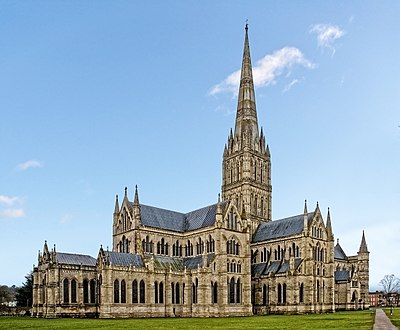Salisbury Cathedral
| Cathedral of the Blessed Virgin Mary, Salisbury | |
|---|---|
| Cathedral of Saint Mary | |

Salisbury Cathedral from the East
|
|
| Coordinates: 51°03′53″N 1°47′51″W / 51.06472°N 1.79750°W | |
| Location | Salisbury, Wiltshire |
| Country | England |
| Denomination | Church of England |
| Website | www.salisburycathedral.org.uk |
| Architecture | |
| Previous cathedrals | 2 |
| Architect(s) | Bishop Richard Poore, Elias of Dereham |
| Style | Early English Gothic |
| Years built | 1220–1320 |
| Specifications | |
| Length | 134.7 metres (442 ft) |
| Choir height | 25.6m |
| Number of towers | 1 |
| Tower height | 68.5 metres (225 ft) (without spire) |
| Number of spires | 1 |
| Spire height | 123 metres (404 ft) |
| Administration | |
| Diocese | Salisbury (since 1220) |
| Province | Canterbury |
| Clergy | |
| Bishop(s) | Nick Holtam |
| Dean | June Osborne |
| Precentor | Tom Clammer |
| Canon Chancellor | Ed Probert |
| Canon Treasurer | Dame Sarah Mullally |
| Laity | |
| Organist(s) | David Halls |
| Chapter clerk | Katrine Sporle |
| Lay member(s) of chapter | Jane Barker Luke March Lydia Brown Eugenie Turton |
Salisbury Cathedral, formally known as the Cathedral Church of the Blessed Virgin Mary, is an Anglican cathedral in Salisbury, England, and one of the leading examples of Early English architecture. The main body of the cathedral was completed in only 38 years, from 1220 to 1258.
The cathedral has the tallest church spire in the United Kingdom (123m/404 ft). Visitors can take the "Tower Tour" where the interior of the hollow spire, with its ancient wood scaffolding, can be viewed. The cathedral also has the largest cloister and the largest cathedral close in Britain (80 acres (32 ha)). It contains the world's oldest working clock (from AD 1386) and has the best surviving of the four original copies of Magna Carta (all four original copies are in England). In 2008, the cathedral celebrated the 750th anniversary of its consecration.
The cathedral is the mother church of the Diocese of Salisbury and seat of the Bishop of Salisbury, currently the Right Reverend Nick Holtam.
As a response to deteriorating relations between the clergy and the military at Old Sarum Cathedral, the decision was taken to resite the cathedral and the bishopric was moved to Salisbury. The move occurred during the tenure of Bishop Richard Poore, a wealthy man who donated the land on which it was built. The new cathedral was paid for by donations, principally from the canons and vicars of southeast England who were asked to contribute a fixed annual sum until it was completed. A legend tells that the Bishop of Old Sarum shot an arrow in the direction he would build the cathedral but the arrow hit a deer that died in the place where Salisbury Cathedral is now. The cathedral crossing, Old Sarum and Stonehenge are reputed to be aligned on a ley line, though Clive L.N. Ruggles asserts that the site, on marshland, was chosen because a preferred site several miles to the west could not be obtained.
...
Wikipedia

